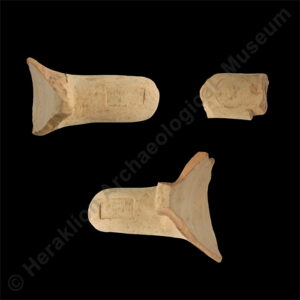
The pointed amphora of Rhodes was a particularly widespread type of storage and transport vessel in Late Classical and Roman times. It appeared in the late 4th c. BC and developed typologically before acquiring its established shape in the 3rd c. BC. The systems of stamping the handles of Rhodian amphorae provide important information, both on the dating of the vessels themselves and for the establishment of chronological systems based on the impressions. The practice of stamping amphora handles emerged in Rhodes in the 3rd c. BC, continued for about two-and-a-half centuries and was abandoned in the Augustan era. Rhodian workshops used the two emblems also seen on the city’s coin: the rose, the symbol of Rhodes (the name of the island means “rose” in ancient Greek), and the rayed sun-god Helios. They also inscribed the names of the amphora-maker and the eponymous archons. The discovery of large numbers of stamped Rhodian amphorae at various sites of the Mediterranean and the Black Sea is evidence of the crucial role of Rhodes in long-distance trade and the movement of goods such as wine, grain and olive oil.